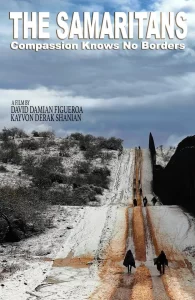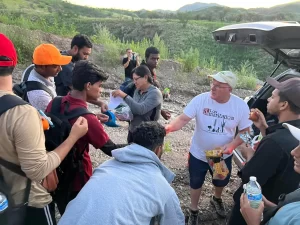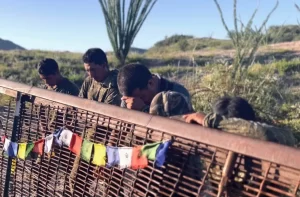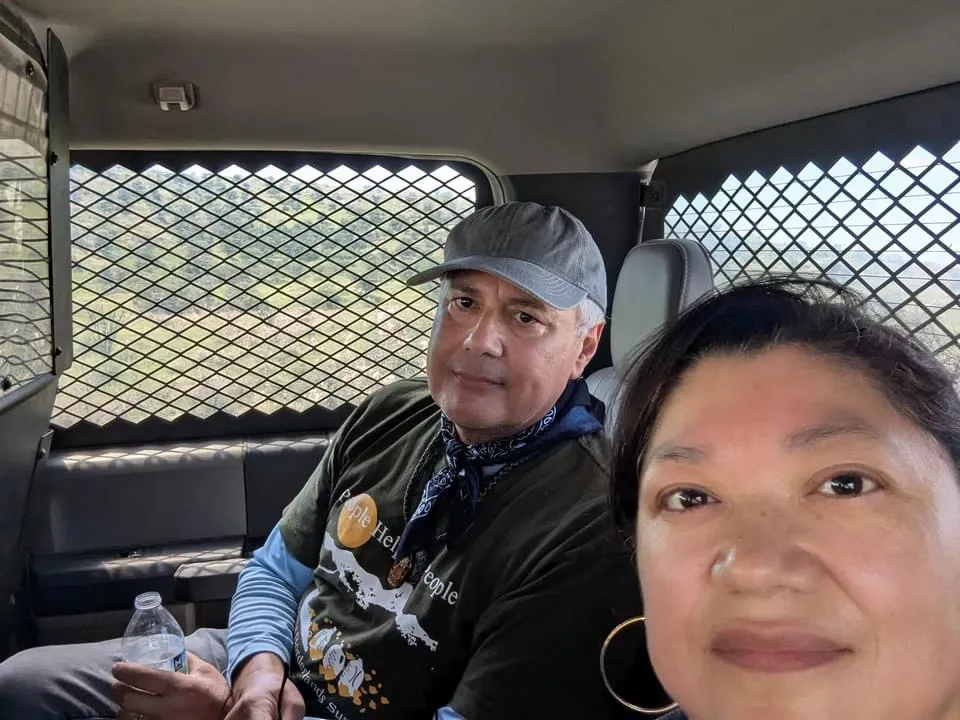The following article was originally published by Todd Miller from The Border Chronicle on August 29, 2024.
“We can’t do our job without taking ethnicity into account. We are very dependent on that.” —DHS official
It was about 10:30 in the morning on August 14 when the silver SUV rumbled down Tres Bellotas Road, about seven miles north of the U.S.-Mexico divide in southern Arizona. Everyone in the vehicle was tired. There were four people, including the acclaimed author Reyna Grande, who was also the executive producer of the documentary they had been working on all morning about the Samaritans, a humanitarian aid organization. They intend the documentary to be a feature-length sequel to the short called Shura, codirected by David Damian Figueroa, who was also in the vehicle along with Randy Mayer, the pastor of the Good Shepherd United Church of Christ in southern Arizona, and a production crew member who wishes not to be named.
Their vehicle passed a green-striped Border Patrol truck. Mayer waved at the agent. Though their missions were often at odds, maintaining a cordial relationship with the enforcement agency has long been the norm for the Samaritans, who have been working in the southern Arizona borderlands for two decades helping migrants in distress. As they passed by, Figueroa, who was sitting in the passenger seat, noticed something. The agent did not wave back. That was the first sign that something was up.
They had gotten up at 4:30 a.m. to film the sunrise at the end of the border wall, near the vehicle barriers near where wall construction ended in the final months of the Trump administration. Figueroa—who comes from a family of farmworkers of Mexican descent from Arizona—said that they wanted to get footage of all seasons and all times of the day. This was the second of two days filming here. At the end of the wall, there was a makeshift humanitarian relief center, where aid groups such as Doctors without Borders, Samaritans, and No More Deaths often congregated. The place was busy that morning. Overnight, many people had crossed the border, mainly from Mexico and Central America, but also from Asia and Africa. People were distributing food, water, and medical aid, including Figueroa, Mayer, and Grande. There were priests doing blessings. The asylum seekers then waited to be picked up by Border Patrol.

After they passed the agent, Figueroa looked in the rearview mirror, and the green-striped Border Patrol vehicle was behind them, lights flashing. Mayer pulled to the side of the dirt road. They were in the high desert, surrounded by rocky terrain and patches of mesquite trees.
The agent was all business. He wore a hat and sunglasses. He had a radio strapped to the front of his uniform and a strap that went right through the middle of the patch with his name. Almost immediately a CBP helicopter appeared and loudly circled overhead. The production crew member got it all on camera, and provided the footage to me (you can see some of the incident in the video below).
“Are you United States citizens?” the agent asked.
“Absolutely,” came the strongest voice from the car.
“Were you just on the border road right now?”
Mayer said something, but the agent said he couldn’t hear him and asked him to step out of the vehicle and to bring his keys. This was the first indication of what the Border Patrol suspected: that they were transporting migrants. As they would soon find out, the migrants—in the view of the agent—were the two Mexican Americans in the SUV.
“And you are all saying that you are U.S. citizens?” the agent asked again.
“Absolutely.”
“No?” the agent strangely answered.
“Yes. Yes,” came several voices from the car, insisting that everyone had citizenship.
Finally, Figueroa asked, and with a tint of frustration in his voice, “What are you stopping us for?”
“It’s a vehicle inspection,” the agent replied.
VIEW VIDEO ON THE BORDER CHRONICLE
After Mayer got out of the SUV, the agent had him sit at the back of the vehicle in the direct sun. Then he focused on Figueroa and Grande, the Mexican Americans. At first, the insinuation was that they were border crossers. The agent patted down Figueroa, who stood legs spread and arms raised against the Border Patrol vehicle. Figueroa handed the agent his passport, which he carries even though he doesn’t have to, since he’s a U.S. citizen. “You know why I had it?” he told me. “Because I’m Latino.” The agents never asked the fair-skinned Mayer for his identification. Mayer told me that if Grande and Figueroa had been “two white guys, this probably wouldn’t have happened.”
A telling moment about the Border Patrol’s racial profiling came in 2014, when the Obama administration issued new rules to curtail the practice among federal agencies. The one exception was Homeland Security. A DHS official told the New York Times, “We can’t do our job without taking ethnicity into account. We are very dependent on that.” Late that year the Obama administration released its guidelines on race and policing that explicitly permitted federal immigration law enforcement to profile. Geographer Reece Jones writes that these guidelines, that are still in effect, need to be revised since they are a violation of the Civil Rights Act.
The agent forced Figueroa into the caged area in the back of the Border Patrol vehicle and shut the door. Then he came for the best-selling author. According to Grande, he had her self-frisk. He asked if she was in the United States legally. He asked her this three times. Each time she answered yes. Each time she was looking at her U.S. passport, which the agent held in his hand. Then the agent asked if she had gone into Mexico and come back. Grande answered that she had passed the vehicle barrier with Figueroa to pick up trash when they were at the end of the border wall.
Later, Grande told me that Mayer had quickly approached them and told them to come back. “They’ve got cameras everywhere,” he told them, and you don’t know what the Border Patrol will do. They returned immediately. In an interview, Mayer told me that “humanitarian groups have an understanding that we don’t want to go beyond the vehicle barriers. We don’t know where the boundary is.”
Figueroa mentioned that the barriers aren’t along the international boundary, which is marked by obelisks. “We didn’t cross the border,” he told me.

Regardless, the agent wanted to know how many feet Grande gone past the barriers. The sun was beating down. Mayer was forced to sit in the direct sun, “without my hat.” And Figueroa was in the caged back section of the Border Patrol vehicle. The car was off, with no air-conditioning, every window closed, and no ventilation. Then the agent forced Grande inside the heating-up mobile jail.
“It was definitely pretty traumatizing for me,” Grande told me, as someone who crossed the border as a child, “and was caught by Border Patrol twice, put in trucks, and sent back to Mexico.” Grande writes about this in her memoirs The Distance Between Us and A Dream Called Home. “Part of me knew something like that could happen [while working on the border]. That was the risk I was taking. And it gave more insight into what Latinos risk. How they racially profile. How there is a risk in being detained.”
No wonder there are so few Latino volunteers for the humanitarian aid organizations on the border, Figueroa said. “They fear being deported.” Mass roundups of Mexicans and Mexican Americans have happened in U.S. history, in the 1930s during the Great Depression and in the 1950s, under the derogatorily named Operation Wetback. And now Donald Trump is threatening to do this again if he wins in November.
The DHS’s practice of taking “ethnicity into account” has been documented widely. For example, according to a 2012 investigation called Justice Derailed, CBP used skin complexion to classify 2,776 people it had arrested from 2005 to 2009, during “transportation raids” of Amtrak trains and Greyhound buses at the Rochester, New York, station. The results: 71.2 percent of the arrestees were “medium complexion,” and 12.9 percent were “black.” Only 0.9 percent were of “fair” complexion. If you are brown, the report suggests, you are the primary target.
“Racial profiling has long been an issue when it comes to border enforcement,” Thomas A. Saenz, president and general counsel of the Mexican American Defense and Education Fund (MALDEF), told me. “The Border Patrol still, in my view, works in stereotypes and targets those who happen to be Latino.”
He said this is especially concerning since politicians have popularized the “dangerous rhetoric” of an immigrant “invasion.”

Sociologist Douglas Massey wrote in 2009 that “undocumented immigrants are not perceived as fully human at the most fundamental neural level of cognition, thus opening a door to the harshest, most exploitive, and cruelest treatment that human beings are capable of inflicting on one another.”
Examples of verbal abuse abound. In 2017, Border Patrol agent Matthew Bowen rammed a Guatemalan man twice with his truck. The investigation that followed revealed that Bowen had previously sent many racist texts to his colleagues, including one that called migrants “disgusting subhuman shit unworthy of being kindling in a fire.” In court, Bowen’s attorney defended him by saying that such language was part of the agency’s culture, that it was “commonplace.” The Border Patrol’s peculiar jargon includes tonk, a word for migrants that refers to the sound of a flashlight hitting someone’s head. According to a report by the ACLU, in 2014, 50 children in Border Patrol detention reported verbal abuse. “You’re the garbage that contaminates this country” was but one example. The sort of abuse also was reported in No More Deaths 2011 report, A Culture of Cruelty: Abuse and Impunity in Short Term U.S. Border Patrol Detention.
All this is both continuing and spreading throughout the country. In a March press release, Kathleen Kersh, an attorney with an Ohio-based legal services group, said, “For over fifteen years, our Latinx and farmworker client communities have been targeted by Ohio’s local law enforcement and Border Patrol’s unjust collaboration.” Citing data from a study, she said it showed “what our clients have always known: this collusion unfairly targets Latinx individuals and people of color. Thousands of miles away from the southern border, we see families separated and individuals discriminately fast-tracked through the deportation pipeline.”
In the back of the heating-up truck, Grande turned on her camera. At this point, they did not know what was going to happen. Anything could happen. Now there were several agents and they indicated the vehicle that they saw on their cameras at the border had a cooler and a white bag, just like the Samartians vehicle had. But Mayer, Figueroa, and Grande told me that they retrieved both the bag and cooler after they were at the wall, when they were at the ranch where they had stayed the night before. “That’s when I felt the conversation wasn’t honest,” Figueroa told me. He continued by saying, “anybody can just like put you through the ringer just because of what you look like. … But my heart goes out to the people who are undocumented because this kind of shit is going on. This is the kind of treatment they get.”



